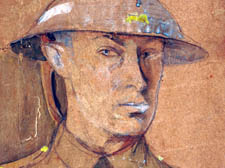|
|
 |
| |

Self-portrait in a steel helmet, 1916 |
The other life of a great war poet
Gerald Isaaman previews an exhibition of Isaac Rosenberg’s paintings 90 year after his death in the final months of the First World War
THE amazing photograph shows the students of the Slade School of Art on a summer outing in 1912.
It presents a turbulence of talent, the faces on display including those of Stanley Spencer, Mark Gertler, David Bomberg, Christopher Nevinson, Adrian Allinson, and the vivacious Dora Carrington (seated front left) who drove men wild with desire.
And kneeling on the edge of the picture, virtually by himself, is the slim figure of Isaac Rosenberg looking white-faced and intense as ever, confident in his artistic skills inspired
by the Pre-Raphaelite painters he so admired.
Unlike most of the well-heeled public school figures who teased him, he was an outsider from London’s East End, along with his close friend Bomberg, who used to walk to Gower Street, Bloomsbury, every day because he couldn’t afford the bus fare and halfpenny for a cup of coffee.
Rosenberg managed to find himself a series of tatty rooms that served as a studio, first in Ampthill Square, Hampstead Road, then in St George’s Square, Primrose Hill, and finally at 32 Carlingford Road, Hampstead, where he stayed the longest time before his life was changed totally by the First World War.
Today, Rosenberg is known as one of the finest war poets, one with almost 1,000 sites on Google about him, homage paid now at the Imperial War Museum and all round the world, much due to his promotion by the late Ike Horvitch, the Hampstead architect who was his nephew.
Years ago I saw my first Rosenberg paintings on the walls of Ike’s old home in Hollycroft Avenue.
Now you too can enjoy Rosenberg’s other considerable talent at an exhibition – Isaac Rosenberg and his Circle – which opens at the Ben Uri Gallery in Swiss Cottage on Tuesday.
It was, ironically, on April 1, 1918, that Rosenberg died, aged 27, while on night patrol near Arras in northern France, his body never identified.
Significantly, the exhibition marks the 90th anniversary of the end of the First World in which thousands died in the rat-filled trenches. And it is the first to focus on the remarkable poet-painter whose words written in pencil on scraps of paper are now so treasured.
“His true vocation was poetry, and he thought of himself as a poet rather than a painter,” says the poet Laurence Binyon. Yet Private Rosenberg, recruit number 22311, never joined the Suffolk Rifles for patriotic reasons. “Nothing can justify war,” he always insisted.
“I suppose we must all fight to get the trouble over. I thought if I’d join there would be the separation allowance for my mother… but mother hasn’t received a farthing.”
It was the “dark destiny of man” he wrote about that engulfed him but left us with his enduring legacy.
* |

|
 |
|
 |
|

